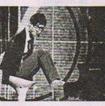小题1:Since he fell off the bike, John _____________(stay) in bed for a week.小题2:---What is his plan after leaving school? ---- He _______________(go) to Beij-九年级英语
题文
小题1:Since he fell off the bike, John _____________(stay) in bed for a week. 小题2:---What is his plan after leaving school? ---- He _______________(go) to Beijing for education. 小题3:Could you please ________________(not speak) so loud? 小题4:David preferred __________(sell) newspapers to doing housework when he was young. 小题5:The teacher has finished ________________(interview) the parents. 小题6:You _________________(not laugh) at disabled people.It’s impolite. 小题7:If I ________(be) you, I would help the homeless people. 小题8:You should say “Thank you” when you ________(give) something as a present by your friends. 小题9:-------I called you yesterday night, but you were not at home. ------ I ____________(drive) home on the way at that time. 小题10:Young children should __________(allow) to choose their own clothes. |
答案
小题1:has stayed 小题2:is going/will go 小题3:not speak 小题4:selling 小题5:interviewing 小题6:shouldn’t/can’t 小题7:were 小题8:are given 小题9:was driving 小题10:be allowed |
小题1:本题后半句的含义为约翰待在床上待了一周的时间,表示做某事的时长用现在完成时,结构为have或has+过去分词stayed,故本题空格处填has stayed。 小题2:本题的含义为为了教育他打算去北京,表示计划可用be going 或will+动词原形,故本题空格处填is going/will go。 小题3:情态动词could跟动词原形speak,否定形式在动词前直接加not即可,故本题空格处填not speak。 小题4:表示喜欢做某事而不喜欢做什么可用prefer doing to doing的形式来表示,故本题空格处填selling。 小题5:finish doing sth表示完成做某事,故本题空格处填interviewing。 小题6:本句的含义你不应该嘲笑残疾人或者说你不能够嘲笑残疾人,故本题空格处填shouldn’t/can’t。 小题7:本题中的if在虚拟句中使用,条件句遇到be用were,故本题空格处填were。 小题8:本题从句的含义为别人给你东西表示被动的意思,结构为be+给的过去分词given,故本题空格处填are given。 小题9:表示昨天晚上正在发生的事用过去进行时,结构为was或were+现在分词doing,故本题空格处填was driving。 小题10:本题的含义为孩子们应该被允许选择他们自己的衣服,表示被动使用被动句,还有情态动词应该写成be+动词的过去分词,故本题空格处填be allowed。 |
据专家权威分析,试题“小题1:Since he fell off the bike, John _____________(stay) i..”主要考查你对 物主代词,单词、词组 等考点的理解。关于这些考点的“档案”如下:
物主代词单词、词组
考点名称:物主代词
- 物主代词:
表示所有关系的代词叫做物主代词,也叫人称代词的所有格。
物主代词分为形容词性物主代词和名词性物主代词两种。
物主代词有人称和数的变化。第三人称单数的物主代词还有性别的变化。 物主代词的用法:
物主代词既有表示所属的作用又有指代作用,例如:
John had cut his finger; apparently there was a broken glass on his desk.
约翰割破了手指,显而易见,他桌子上有个破碎的玻璃杯。
物主代词有形容词性(my, your等)和名词性(mine, yours等)两种:
形容词性的物主代词属于限定词。
名词性的物主代词在用法上相当于省略了中心名词的 -'s属格结构,例如:
Jack's cap 意为 The cap is Jack's.
His cap 意为 The cap is his.形容词性物主代词用法:
1. 形容词性物主代词相当于形容词,在句中只能用作定语,后面必须跟名词。名词性物主代词常用来避免和前面已提及的名词重复。
相当于【形容词性物主代词+名词】。例如:
Is that yourbike? 那是你的自行车吗?
My pen is quite different from his.
2. 如果名词前用了形容词性物主代词,就不能再用冠词(a, an, the)、指示代词(this, that, these, those)等修饰词了。例如:
这是他的书桌。This is his desk.
3. 与形容词一起修饰名词时,形容词性物主代词要放在形容词的前面。例如:
his English books他的英语书。
their Chinese friends他们的中国朋友。
4. 汉语中经常会出现"我妈妈","你们老师"等这样的语言现象,虽然代词用的是"我"、"你们",但实际意义仍是"我的"、"你们的",
所以在英译时,注意要用形容词性物主代词"my","your"。
例如:你妈妈在家吗?
误:Is you mother at home?
正:Is yourmother at home?
5. it's与its读音相同,he's与his读音相似,但使用时需注意它们的区别(it's和he's分别是it is和he is的缩略形式,但its 和his 却是形容词性物主代词) 。
例如: It's a bird. Its name is Polly. 它是一只鸟。它的名字叫波利。
He's a student. His mother is a teacher. 他是一名学生。他妈妈是一位教师
口诀:
有“名”则"形“,无“名”则“名”。
意思是:后面是名词的话,前面就要用 形容词性物主代词。后面没有名词的话,就用名词性物主代词。名词性物主代词的句法功能:
a. 作主语,例如:
May I use your pen? Yours works better.
我可以用一用你的钢笔吗? 你的比我的好用。
b.作宾语,例如:
I love my motherland as much as you love yours.
我爱我的祖国就像你爱你的祖国一样深。
c.作介词宾语,例如:
You should interpret what I said in my sense of the word, not in yours.
你应当按我所用的词义去解释我说的话,而不能按你自己的意义去解释。
d.作主语补语,例如:
The life I have is yours. It's yours. It's yours. 我的生命属于你,属于你,属于你。
名词性物主代词可以用在介词of的后面,相当于“of+名词所有格”。
口诀
有“名”则"形“,无“名”则“名”。
注:
后面是名词的话,前面就要用 形容词性物主代词。
后面没有名词的话,就用名词性物主代词.形容词性物主代词与名词性物主代词的区别:
一.形容词性物主代词起形容词的作用,用在名词前。
例:
1. This is my book.这是我的书。
2. We love our motherland.我们热爱我们的祖国。
二.名词性物主代词起名词的作用。
例:
1. Look at the two pencils. The red one is yours and the blue one is mine.
看那两支铅笔,红的是你的,蓝的是我的。
2. He likes my pen. He doesn't like hers.
他喜欢我的钢笔。不喜欢她的。
3. 注意:在使用名词性物主代词时,必须有特定的语言环境,也就是要省略的名词。
例:
It's hers.是她的。
(单独使用大家不知是怎么回事,不可以这样用)
There is a book. It's hers.那有本书。是她的。
(先提及,大家才明白)
4. 名词性物主代词=形容词性物主代词+名词
为避免重复使用名词,有时可用“名词性物主代词”来代替“形容词性物主代词+名词”的形式。
例:
My bag is yellow, her bag is red, his bag is blue and your bag is pink.
为避免重复使用bag,可写成My bag is yellow, hers is red, his is blue and yours is pink.物主代词“形”变“名”歌:
形物代变名物代
掌握规律变得快
多数词尾加-- s
my,its,his要除外
my把y来变成i
- 最新内容
- 相关内容
- 网友推荐
- 图文推荐
| [家长教育] 孩子为什么会和父母感情疏离? (2019-07-14) |
| [教师分享] 给远方姐姐的一封信 (2018-11-07) |
| [教师分享] 伸缩门 (2018-11-07) |
| [教师分享] 回家乡 (2018-11-07) |
| [教师分享] 是风味也是人间 (2018-11-07) |
| [教师分享] 一句格言的启示 (2018-11-07) |
| [教师分享] 无规矩不成方圆 (2018-11-07) |
| [教师分享] 第十届全国教育名家论坛有感(二) (2018-11-07) |
| [教师分享] 贪玩的小狗 (2018-11-07) |
| [教师分享] 未命名文章 (2018-11-07) |


![—______ is Jenny.—I’m Gina. Nice to meet you.[ ]A. I’mB. His nameC. I’mD. My name-七年级英语](http://www.00-edu.com/d/file/ks/4/2/wuzhudaici/2019-11-29/small48b153aa794daeb090c5d2505d5cbbac1575042450.png)



